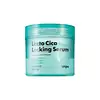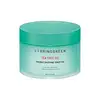What's inside
What's inside
 Key Ingredients
Key Ingredients

 Benefits
Benefits

 Concerns
Concerns

 Ingredients Side-by-side
Ingredients Side-by-side

Water
Skin ConditioningMethylpropanediol
SolventGlycerin
HumectantLimnanthes Alba Seed Oil
Skin ConditioningCentella Asiatica Leaf Extract
Skin ConditioningMadecassoside
AntioxidantAsiaticoside
AntioxidantBifida Ferment Filtrate
Skin ConditioningBifida Ferment Lysate
Skin ConditioningLactobacillus Ferment Lysate
Skin ConditioningLactococcus Ferment Lysate
Skin ConditioningSaccharomyces Ferment Filtrate
HumectantVincetoxicum Atratum Extract
Skin ConditioningHydrolyzed Algin
Chlorella Vulgaris Extract
Skin ConditioningHibiscus Esculentus Fruit Extract
Skin ConditioningDioscorea Oppositifolia Root Extract
Skin ConditioningLinum Usitatissimum Seed Extract
PerfumingSalvia Hispanica Seed Extract
EmollientAlthaea Rosea Flower Extract
Skin ConditioningSodium Hyaluronate
HumectantSodium Hyaluronate Crosspolymer
HumectantHydrolyzed Jojoba Esters
Skin ConditioningGlucose
HumectantAllantoin
Skin ConditioningFructooligosaccharides
HumectantFructose
HumectantHydrogenated Lecithin
EmulsifyingAcetyl Glucosamine
Skin ConditioningBiosaccharide Gum-1
HumectantCaffeine
Skin ConditioningMelaleuca Alternifolia Leaf Oil
AntioxidantPropanediol
SolventButylene Glycol
HumectantPentylene Glycol
Skin ConditioningPolyglyceryl-10 Oleate
Skin ConditioningPolyglyceryl-3 Methylglucose Distearate
Emulsifying1,2-Hexanediol
Skin ConditioningAcrylates/C10-30 Alkyl Acrylate Crosspolymer
Emulsion StabilisingPolyglyceryl-10 Laurate
Skin ConditioningCaprylyl Glycol
EmollientEthylhexylglycerin
Skin ConditioningHydroxyacetophenone
AntioxidantTromethamine
BufferingCitric Acid
BufferingXanthan Gum
EmulsifyingDisodium EDTA
Water, Methylpropanediol, Glycerin, Limnanthes Alba Seed Oil, Centella Asiatica Leaf Extract, Madecassoside, Asiaticoside, Bifida Ferment Filtrate, Bifida Ferment Lysate, Lactobacillus Ferment Lysate, Lactococcus Ferment Lysate, Saccharomyces Ferment Filtrate, Vincetoxicum Atratum Extract, Hydrolyzed Algin, Chlorella Vulgaris Extract, Hibiscus Esculentus Fruit Extract, Dioscorea Oppositifolia Root Extract, Linum Usitatissimum Seed Extract, Salvia Hispanica Seed Extract, Althaea Rosea Flower Extract, Sodium Hyaluronate, Sodium Hyaluronate Crosspolymer, Hydrolyzed Jojoba Esters, Glucose, Allantoin, Fructooligosaccharides, Fructose, Hydrogenated Lecithin, Acetyl Glucosamine, Biosaccharide Gum-1, Caffeine, Melaleuca Alternifolia Leaf Oil, Propanediol, Butylene Glycol, Pentylene Glycol, Polyglyceryl-10 Oleate, Polyglyceryl-3 Methylglucose Distearate, 1,2-Hexanediol, Acrylates/C10-30 Alkyl Acrylate Crosspolymer, Polyglyceryl-10 Laurate, Caprylyl Glycol, Ethylhexylglycerin, Hydroxyacetophenone, Tromethamine, Citric Acid, Xanthan Gum, Disodium EDTA
Melaleuca Alternifolia Leaf Extract
PerfumingWater
Skin ConditioningCentella Asiatica Extract
CleansingButylene Glycol
HumectantMelaleuca Alternifolia Leaf Water
Antimicrobial1,2-Hexanediol
Skin ConditioningMelaleuca Alternifolia Flower/Leaf/Stem Extract
Skin ConditioningBetaine
HumectantDipropylene Glycol
HumectantHydroxyacetophenone
AntioxidantAllantoin
Skin ConditioningPanthenol
Skin ConditioningMelaleuca Alternifolia Leaf Oil
AntioxidantCarbomer
Emulsion StabilisingPolyglyceryl-10 Laurate
Skin ConditioningXanthan Gum
EmulsifyingArginine
MaskingDisodium EDTA
Ethylhexylglycerin
Skin ConditioningCapryloyl Salicylic Acid
Exfoliating4-Terpineol
MaskingMelaleuca Alternifolia Leaf Extract, Water, Centella Asiatica Extract, Butylene Glycol, Melaleuca Alternifolia Leaf Water, 1,2-Hexanediol, Melaleuca Alternifolia Flower/Leaf/Stem Extract, Betaine, Dipropylene Glycol, Hydroxyacetophenone, Allantoin, Panthenol, Melaleuca Alternifolia Leaf Oil, Carbomer, Polyglyceryl-10 Laurate, Xanthan Gum, Arginine, Disodium EDTA, Ethylhexylglycerin, Capryloyl Salicylic Acid, 4-Terpineol
 Reviews
Reviews

Ingredients Explained
These ingredients are found in both products.
Ingredients higher up in an ingredient list are typically present in a larger amount.
1,2-Hexanediol is a synthetic liquid and another multi-functional powerhouse.
It is a:
- Humectant, drawing moisture into the skin
- Emollient, helping to soften skin
- Solvent, dispersing and stabilizing formulas
- Preservative booster, enhancing the antimicrobial activity of other preservatives
Allantoin is a soothing ingredient known for its protective and moisturizingg properties. Because of this, it is often added to products with strong active ingredients.
Studies show higher concentrations of this ingredient can promote wound healing.
Though it can be derived from the comfrey plant, allantoin is produced synthetically for cosmetic products to ensure purity.
Learn more about AllantoinButylene Glycol (or BG) is used within cosmetic products for a few different reasons:
Overall, Butylene Glycol is a safe and well-rounded ingredient that works well with other ingredients.
Though this ingredient works well with most skin types, some people with sensitive skin may experience a reaction such as allergic rashes, closed comedones, or itchiness.
Learn more about Butylene GlycolDisodium EDTA plays a role in making products more stable by aiding other preservatives.
It is a chelating agent, meaning it neutralizes metal ions that may be found in a product.
Disodium EDTA is a salt of edetic acid and is found to be safe in cosmetic ingredients.
Learn more about Disodium EDTAEthylhexylglycerin (we can't pronounce this either) is commonly used as a preservative and skin softener. It is derived from glyceryl.
You might see Ethylhexylglycerin often paired with other preservatives such as phenoxyethanol. Ethylhexylglycerin has been found to increase the effectiveness of these other preservatives.
Hydroxyacetophenone is antioxidant with skin conditioning and soothing properties. It also boosts the efficiency of preservatives.
This ingredient is not irritating or sensitizing.
This tea tree oil comes from the leaves of the Tea Tree plant. Tea tree oil has antioxidant, anti-inflammatory, and antimicrobial properties.
According to the book Journal of Profiles of Drug Substances, tea tree helps in reducing acne-causing bacteria such as Propionibacterium acnes. This is due to the Terpinen components of tea tree oil.
Tea tree may cause sensitivity and irritation for some people. This oil naturally contains fragrance such as linalool and limonene.
However, research shows irritation usually occurs when using pure tea tree oil and not in cosmetic products.
Tea tree oil was found to help relieve the symptoms of psoriasis in one study.
Tea tree oil is toxic when ingested. Another study showed it to caused damage to the nervous system of dogs and cats when applied to their skin or given orally.
Learn more about Melaleuca Alternifolia Leaf OilPolyglyceryl-10 Laurate is an ester of lauric acid and Polyglycerin-10.
Polyglyceryl-10 Laurate is a cleansing agent and emulsifier. It helps gather dirt, oil, and other pollutants to be rinsed away. As an emulsifier, it helps prevent ingredients from separating, such as oil and water.
Polyglyceryl-10 Laurate may not be fungal acne safe.
Learn more about Polyglyceryl-10 LaurateWater. It's the most common cosmetic ingredient of all. You'll usually see it at the top of ingredient lists, meaning that it makes up the largest part of the product.
So why is it so popular? Water most often acts as a solvent - this means that it helps dissolve other ingredients into the formulation.
You'll also recognize water as that liquid we all need to stay alive. If you see this, drink a glass of water. Stay hydrated!
Learn more about WaterXanthan gum is used as a stabilizer and thickener within cosmetic products. It helps give products a sticky, thick feeling - preventing them from being too runny.
On the technical side of things, xanthan gum is a polysaccharide - a combination consisting of multiple sugar molecules bonded together.
Xanthan gum is a pretty common and great ingredient. It is a natural, non-toxic, non-irritating ingredient that is also commonly used in food products.
Learn more about Xanthan Gum